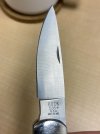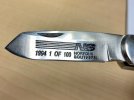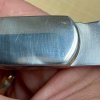- Joined
- Sep 13, 2021
- Messages
- 1,450
Here's a neat 535 BuckLock 2. This model ran from 1991 to 1994. As best I know, Buck mostly used 425Mod until 1992, then started using 420HC in 1993. I'm sure there was overlap as they used up existing stock, etc.
This is number 076 out of 100 Norfolk Southern RR knives. The main blade is date stamped 1991, the first year of this model. The secondary blade is stamped 1994, the last year of this model. Of course, this commemorative blade stamping could have been done in 1993 or something as they prepared to deliver the batch of 100 on time.
The two blades also have different finishes, but that could be due to the stamping process for the Norfolk Southern wording.
I realize there's probably no way to know for sure, but it's neat to ponder that this knife may have blades from my two favorite steels. I like to think I would be able to tell if they are different steels if I start sharpening them, but I would have to get after them on the stone harder than I want to on this old knife that looks to have been carried much, and used little. The edges look like they could possibly be untouched. In the 90's I would have been able to tell the difference between the two for sure because Buck 425M and 420HC were the only two steels I owned, and I sharpened aggressively as a younger man, and only owned one double sided stone. I've mellowed since then and use such a variety of stones, ceramics, strops, diamonds, etc. on several different steels that it may be hard to tell these days. But this knife isn't winning any mint condition awards so maybe if I get bored one day... We'll see.
It didn't come to me with the brown leather sheath.
Anyhow, I'm just sort of rambling and letting my mind wander a little. Thanks for listening.
Does anyone have another Norfolk Southern 535 - or any 535? I'd love to see pictures, especially if you have a mint one and better photography skills than a guy with an iPhone who's waiting on his computer to load while drinking his tea. LOL!




This is number 076 out of 100 Norfolk Southern RR knives. The main blade is date stamped 1991, the first year of this model. The secondary blade is stamped 1994, the last year of this model. Of course, this commemorative blade stamping could have been done in 1993 or something as they prepared to deliver the batch of 100 on time.
The two blades also have different finishes, but that could be due to the stamping process for the Norfolk Southern wording.
I realize there's probably no way to know for sure, but it's neat to ponder that this knife may have blades from my two favorite steels. I like to think I would be able to tell if they are different steels if I start sharpening them, but I would have to get after them on the stone harder than I want to on this old knife that looks to have been carried much, and used little. The edges look like they could possibly be untouched. In the 90's I would have been able to tell the difference between the two for sure because Buck 425M and 420HC were the only two steels I owned, and I sharpened aggressively as a younger man, and only owned one double sided stone. I've mellowed since then and use such a variety of stones, ceramics, strops, diamonds, etc. on several different steels that it may be hard to tell these days. But this knife isn't winning any mint condition awards so maybe if I get bored one day... We'll see.
It didn't come to me with the brown leather sheath.
Anyhow, I'm just sort of rambling and letting my mind wander a little. Thanks for listening.
Does anyone have another Norfolk Southern 535 - or any 535? I'd love to see pictures, especially if you have a mint one and better photography skills than a guy with an iPhone who's waiting on his computer to load while drinking his tea. LOL!





